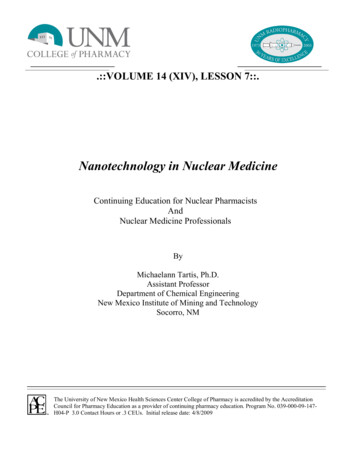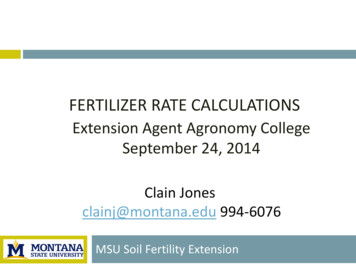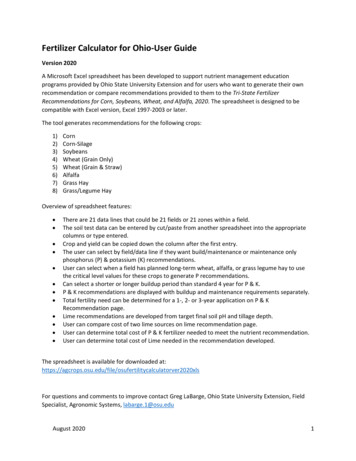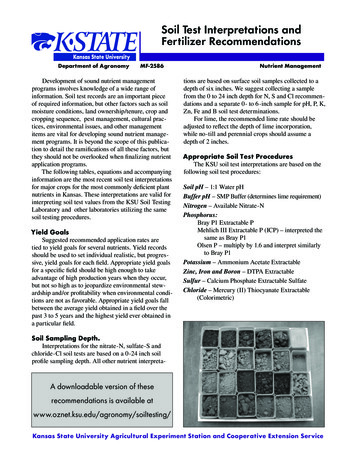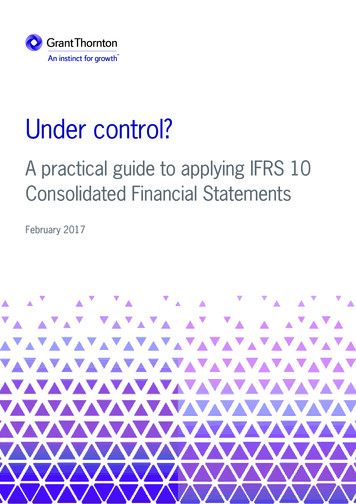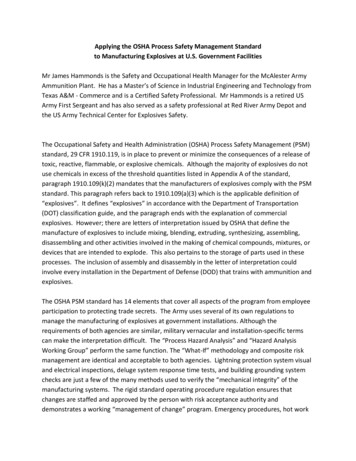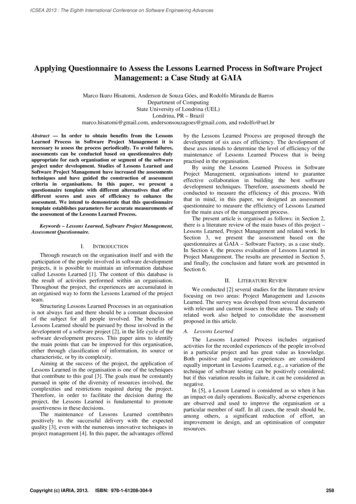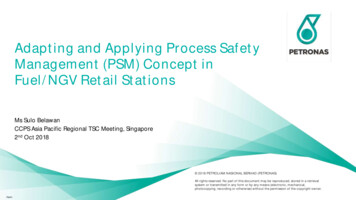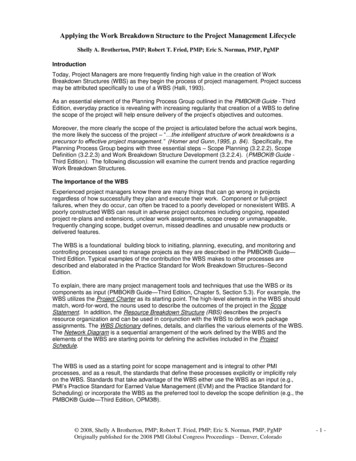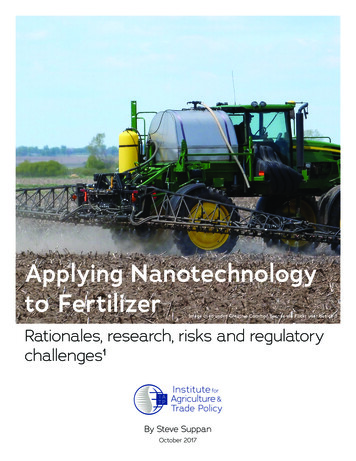
Transcription
Applying Nanotechnologyto FertilizerImage used under Creative Common license via Flickr user basicbillRationales, research, risks and regulatorychallenges1By Steve SuppanOctober 2017
Applying Nanotechnology to Fertilizer: Rationales, research, risks and regulatory challenges1By: Steve SuppanPublished October 2017The Institute for Agriculture and Trade Policy works locally and globallyat the intersection of policy and practice to ensure fair and sustainable food, farm and trade systems.More at iatp.org
OV ERVI E WDependence on more efficient use of synthetic fertilizers toincrease crop yields poses technical, economic and environmental challenges. This article summarizes three proposedapplications of nanotechnology enabled fertilizers (NEFs).Each one of them is intended to increase fertilizer nutrientefficiency uptake in plants and reduce the percentage ofnitrogen that leaches into ground and surface water asnitrates and volatizes as nitrous oxide. (Nitrous oxide makesup only about five percent of all greenhouse gases, but isabout 300 times as potent as carbon dioxide.2) One applicationwould use a nano-composite polymer to bind fertilizer nutrients into pellets that would improve nutrient use efficiencymore than current Controlled Release Fertilizers (CRFs). Thesecond is a proof of concept application that would rely on anano-biosensor embedded in a biopolymer fertilizer coatingto release nutrients (just in time) in response to chemicalsignals from soil microbes in a plant’s root system (rhizosphere). A third, laboratory tested approach, is to amend soilsamples with nano-clays, which create soil micro-structuresto reduce and delay nitrate loaded runoff and release ofammonia and nitrous oxide.3 This mini-survey presents someof the technical problems and environmental risks of eachapproach. It also offers insights regarding broader economicchallenges related to use of nanotechnology enabled CRFs forrow crops.To the extent that industrial scale crop production dependson synthetic fertilizers—and forgoes intensified crop rotationand systemic use of cover crops to reduce negative environmental consequences—nanotechnology is likely to be amongthe technologies of precision agriculture that are hoped tomake the intensification of crop production environmentallysustainable. This brief survey by a non-scientist is intendedto help inform an interested lay public of the status of nanofertilizer development and environmental risk assessment.Some agri-nanotechnology researchers have sounded a loudnote of caution about the research and development challenges to manufacturing and safe use of NEFs. A recentarticle by researchers at the International Fertilizer Development Center states, “large scale industrial productionof nano-fertilizers is yet to be realized,” adding that amongtheir concerns are “toxicity associated with nanoscale materials; scant nanofertilizer research with key crop nutrients;inadequacy of soil or field-based studies with nanofertilizers;[which] types of nanomaterials to produce as nanofertilizers;how to efficiently and effectively apply nanofertilizers at thefield scale; and the economics of nanofertilizers.”4 Our reviewof the studies summarized here affirms these concerns andadds to them.However, the urgent need to increase nutrient uptake efficiency and greatly decrease environmental harms fromsynthetic fertilizer use, particularly from nitrogen-basedfertilizer, will continue to drive research and investmentinto NEFs. It remains to be seen whether nano-fertilizerresearchers will be patient enough to learn from plant physiology and soil science the risk and hazards that some nanomaterials may pose to soil, plant and human health.One research team described an underlying cause of poorperformance by fertilizers:the gap between the intended fertiliser functionalityand their actual impact arises from the fact thatfertilisers are made by chemists, chemical engineersand industrial processing technologists, following lawsof physical and chemical processes, with little inputfrom the knowledge of plant physiology and need foragro-ecological specificity of crop nutrition. A renewedimpetus is, therefore, needed, to arrive at novel waysof packaging and delivering nutrients to plants, basedon a better integration of the plant physiological andecological processes related to the different modes ofnutrient uptake, transport and metabolism.5Understanding specific applications of nanomaterials infertilizer is critical to preventing inadequately researched,field tested and regulated products from exacerbating currentenvironmental and public health problems associated withindustrial scale use of synthetic chemicals. Scientists areunder enormous pressure to deliver technologies to increaseyields that are not only technically reliable but cost-effectivefor the fertilizer industry and for farmers.6 The public has animportant role to play to ensure that any new nano-fertilizerproducts are not rushed to market before their environmentaland public health impacts can be determined, reliably validated, and diminished, if not eliminated, through regulationand product re-design.T H E R O L E O F F ERT I LIZERI N E XPAN D I N G E XP O RT SAN D I N CR E A S I N G YI EL DSThe reports of the Global Harvest Initiative (GHI), “a privatesector policy voice for increasing productivity and sustainability throughout the agricultural value chains for food,feed, fiber and fuel”7 illustrate a global agribusiness approachintended to increase crop yields and exports of those crops.GHI members include Monsanto, Mosaic (a fertilizer companythat was formerly part of Cargill), Dow Elanco Animal Health,John Deere, Novozymes, DuPont, and Farmland Partners, aAPPLYING NANOTECHNOLOGY TO FERTILIZER: RATIONALES, RESEARCH, RISKS AND REGULATORY CHALLENGES:3
large and fast-growing agricultural Real Estate InvestmentTrust.8 Consulting partners to the members include universities, nongovernmental organizations, corporations, andpublicly funded development banks, such as the Inter-American Development Bank (IADB).The GHI project originates in Washington DC and aims to beapplied globally. The Latin American regional version of theGHI reports and analytic framework have been facilitated,adapted and translated by IADB. Brazil is an important casestudy for the application of nanotechnology to increase yieldin export crops, particularly soybeans. Among GHI members,the Brazilian Agricultural Research Corporation (EMBRAPA)investment in nanotechnology includes the developmentof a nanotechnology enabled controlled release fertilizer.The application of nano-clay composites to urea, the richestsource of nitrogen fertilizer, is designed to reduce nitrateleaching into surface and ground water, and its volatilizationas the powerful greenhouse gas, nitrous oxide. According toa press release, “Intelligent fertilizer,” following successfullaboratory and field trial experiments, “is ready to be transferred to the private sector for adjustments to stages of scaleproduction and of trade.”9Before analyzing the technical reporting of NEFs and theirpossible environmental and farm worker health impacts, itis helpful to understand the institutional and agriculturaleconomic context in which commercial release of a nanofertilizer or nanotechnology enabled soil amendment wouldtake place.The Brazilian report, “O próximo celeiro global: Como a AmericaLatina pode alimentar o mundo” [“The next global granary: howLatin America can feed the world”] repeats the GHI solutionto a GHI forecast shortfall in agricultural productivity for lowincome countries:10 “The path to follow: invest in Latin American/Caribbean Agriculture”, the report declares. The areasof investment include agricultural technologies to realize anenvironmentally sustainable intensification of crop and animalproduction and exports of that production to low-income countries.11 The GHI tacitly assumes that low income countries willhave the hard currency, usually dollars, with which to pay forimported agricultural products as advocated by GHI membersand associates. It also tacitly assumes that imports are economically, culturally and environmentally preferable to furtherdevelopment of domestic agricultural production.The Brazilian government advocates for and invests inprecision agriculture for major export crops with the goalof increasing yields by up to 67 percent, although there isno target date by which this increase is to be realized.12The assumption of ever greater yields on ever more plantedhectares13 would entail ever greater use of fertilizer. The4International Plant Nutrition Institute reports the application of the macro-nutrients, nitrogen, potassium and phosphorus in Brazil went from about 7.4 million metric tons in2000 to about 15.2 million metric tons in 2014.14 Part of thisincrease is due to the two to three crops per season that canbe harvested in much of Brazil.15However, scientists have raised serious concerns about thefuture availability of phosphorus and potassium, two of thethree major macro-nutrients for crops.16 The 37 certifiedfertilizer companies in the International Fertilizer IndustryAssociation’s (IFA) “Protect and Sustain Hall of Fame”17 haveagreed on production standards for fertilizer manufacture in45 countries to improve efficient use of those raw materials.The IFA also has nutrient stewardship programs to teachfarmers how to reduce fertilizer overuse.18 To the extent thatindustrial scale agriculture for export depends on chemicallyfertilized monocrops, even with improved fertilizer manufacturing and farmer application techniques, the syntheticfertilizer foundation of industrial agriculture could beexhausted within two generations.Intensive use of cover crops and crop rotation have proven toincrease soil health and reduce the need for chemical fertilizers (and their attendant high costs of production and environmental harms).19 Despite this success, industry continuesto research technological fixes that will be extend the profitability of agribusiness by perpetuating mono-cropping andagricultural trade of a few grains and oilseeds. The application of nanotechnology and nano-scale materials to fertilizeris one such proposed technological fix.R AT I O N A L ESFO R A PPLYI N GN AN OT ECH N O LO GYTO F ERT I LIZERA U.S. researcher neatly summarized the agri-nanotechnology proponents’ imperative for applying the technologyto enable more sustainable intensification of agriculturalproduction along the lines of the GHI agricultural productivity forecasts: “The population is increasing, the climateis changing, making agriculture hard to do. The role ofnanoparticles is to help us address this major problem. Wejust can’t produce enough food.”20 The econometric projectionsunderlying this claimed imperative, which assumes globalfood production must double by 2050—have long been controversial and recently rebutted.21 Whether this neo-Malthusianassessment is accurate or not, nanotechnology is among thetools of precision agriculture that its proponents hope willINSTITUTE FOR AGRICULTURE AND TRADE POLICY
Illustration 1: Atmospheric Nitrogen (N2)Source: Dréo, Johann, "The Nitrogen Cycle," Environmental Protection Agency, September 27, 2009. Accessed October 08, 2017, ia/File:Nitrogen Cycle.svg.increase agricultural production while reducing negativeenvironmental consequences of fertilizer use. An increase inproduction resulting in part from an increase in fertilizer usewith current product technologies would exacerbate currentnegative environmental effects of that use.environment. The U.S. Department of Agriculture’s NaturalResource Conservation Service (NCRS) estimated in 2006that an average of about 40 percent of nitrogen in fertilizerwas lost annually on U.S. crop acreage, with about 18 percentof the total loss coming in the form of greenhouse gases.27According to Professor Stephen Carter, globally “We’vechanged nitrogen and phosphorus cycles vastly more thanany other element . . . [The increase in the nitrogen and phosphorus cycles] is on the order of 200 to 300 percent. In contrast,carbon has only been increased 10 to 20 percent and look atall the uproar that has caused in the climate.”26 The cycledescribes the processes by which nitrogen and phosphorusare changed into various chemical forms, part of whichnourishes plant life and the excess of which is “lost” to theThese estimates are based on computer simulations ofmodeled assumption scenarios that extrapolate from fieldobservation data. A USDA researcher notes, “In general, theaccuracy of model predictions cannot exceed the accuracy ofthe input data used in the analysis.”28 The NRCS estimatesvary widely by crop planted and by region with nitrogenlosses as high as 115 pounds per acre for corn planted in theSoutheastern United States and as low as 12 pounds per acrefor grass hay planted in the Northern Great Plains states. AAPPLYING NANOTECHNOLOGY TO FERTILIZER: RATIONALES, RESEARCH, RISKS AND REGULATORY CHALLENGES:5
An alternative to doubling globalagriculture production for exportto low income countries: improvingpost-harvest storageAs far back as 1975, the United Nations General Assemblyresolved that UN member governments would reduceby 50 percent agricultural crop losses by 1989. In 2006,the African Union resolved to reduce crop losses to 10percent of production by 2015.22 Regrettably, these goalshave been far from realized. One 2016 study reports thatthe estimated post-harvest loss of South Saharan Africanagricultural production is equal in value to that of SSAagricultural imports.23 Former UN Secretary General KofiAnnan has long advocated improving post-harvest storageto reduce agriculture production losses and increase foodsecurity, particularly in Africa. Secretary General Annanoutlined nine steps as crucial to achieve food security,particularly in Africa. Increasing agricultural productivity isjust one.2
GHI members include Monsanto, Mosaic (a fertilizer company that was formerly part of Cargill), Dow Elanco Animal Health, John Deere, Novozymes, DuPont, and Farmland Partners, a . 4 INSTITUTE FOR AGRICULTURE AND TRADE POLICY large and fast-growing agricultural Real Estate Investment Trust.8 Consulting partners to the members include univer-sities, nongovernmental organizations,
